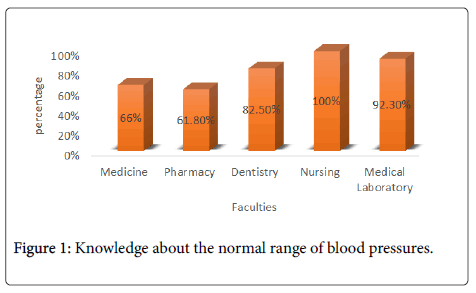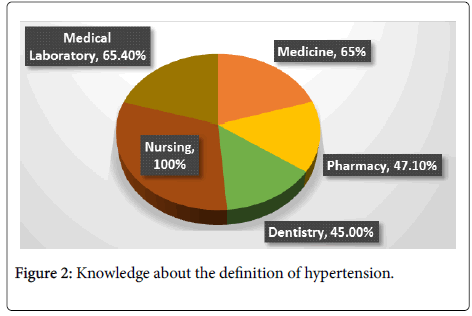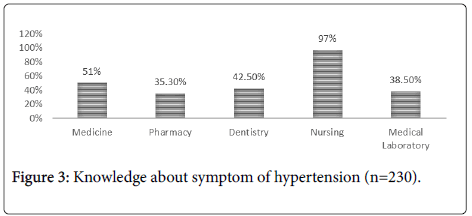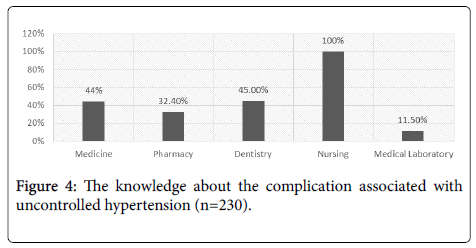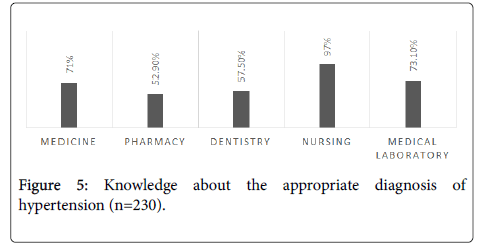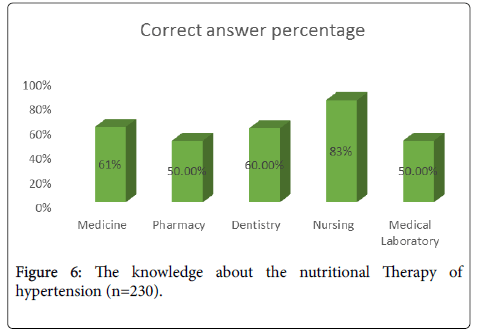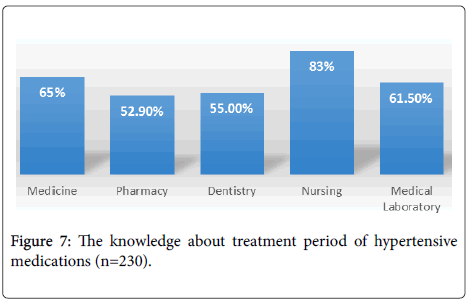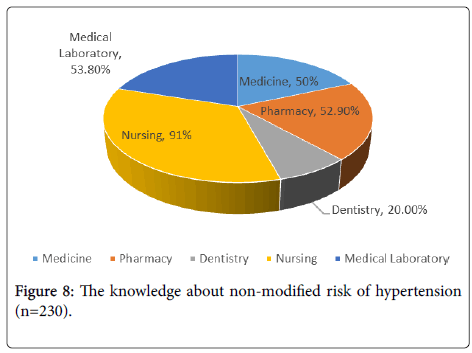Assessment of Knowledge about Hypertension and its Risk Factors among Students form Medical Colleges at IUA
Received: 24-May-2018 / Accepted Date: 11-Jun-2018 / Published Date: 13-Jun-2018 DOI: 10.4172/2476-2024.1000142
Abstract
Objective: Hypertension has been increased dramatically nowadays; this might be due to the modern life which increases the pressure on individuals. So, the study aims to assess the knowledge of risk factors of hypertension among the medical sciences students in International University of Africa (IUA). In the meantime, the relationship between hypertension and physical activity, family history of cardiovascular disease (CVD), and socio-demographic variables were also assessed in this study.
Materials and Methods: A cross-sectional survey among students of the first year in medical colleges, in IUA was conducted. The data obtained was analyzed using PASW, Chi square test, and binary logistic regression analysis was done.
Results: The study revealed that the age of participates was found 20 years 95 (41%), while the gender was found as following male 90 (39%) and 140 (61%) females, none of the participants is a smoker, while only 44(19%) have no family history of Hypertension. However, the faculties of students were found as following medicine 41%, medical laboratory 11%, nursing 15%, pharmacy 14% and dentistry 18%. On the other hand, the knowledge of normal blood pressure. Moreover, the highest prevalence was found 100% in nursing students, 92.3% in medical laboratory, 82.5% in dentistry, 66% in medicine and 61.8% in pharmacy.
Conclusions: The study found a different level of knowledge among first-year students in different medical colleges and many modifications in elementary courses might be needed to fill this gap.
Keywords: Hypertension; Risk factors knowledge; University medical students
Introduction
Hypertension (HTN), known as an increase in the blood pressure; the blood vessels have raised pressure [1]. Hypertension is grouped into four categories for adults of age greater than or equal 18 years, the first, normal blood pressure is where systolic blood pressure (SBP) is less than 120 mmHg and diastolic blood pressure (DBP) is less than 80 mmHg. The second, pre-hypertension is for patients on the cusp of developing hypertension and defined as a SBP of 120-139 mmHg or a DBP of 80-89 mmHg. The third, hypertension which is defined as a systolic blood pressure equal to or above 140 mm Hg and/or diastolic blood pressure equal to or above 90 mmHg. In the meantime, it is divided as stage I with the systolic blood pressure 140-159 mmHg or diastolic blood pressure 80-89 mmHg and stage II with systolic blood pressure ≥ 160 mmHg or diastolic blood pressure of ≥ 100 mmHg.
However, the normal levels of both systolic and diastolic blood pressure are particularly important for the efficient function of vital organs such as the heart, brain and kidneys and for overall health and wellbeing. Furthermore, hypertension is a big universal health problem affecting each one in three adults, and its mortality rate is 1,000 deaths per day. Moreover, hypertension contributes to about 13% of global deaths and acts as the risk factor for other diseases and boosts the risk of cardiovascular morbidity and increase mortality in diabetic patients, but fortunately it can be prevented [2,3].
Otherwise, hypertension is a silent killer because in most situations sit remains asymptomatic and only discovered after a complication develops in susceptible organs causing health problems, like atherosclerotic heart disease, cerebrovascular insufficiency and renal failure [4]. On the other hand, common risk factors of hypertension are aging, hereditary, obesity, weight gain, high sodium intake, low calcium and potassium intake, alcohol consumption, psychological stress and low physical activity [5].
This is study aimed to assess the knowledge about HTN and its risk factors among first year students of the Medical Colleges in the International University of Africa.
Material and Methods
Data were collected from International University of Africa during January to May 2017 via questionnaire format designed to elicit the level of knowledge of student about hypertension (HTN) and its risk factors, a total of 230 students were in rolled in this is study, from different medicals colleges of IUA (first year only). The questionnaire format included information about the age, gender, faculty, using cigarette (smoking) and family history of HTN, and the definition of HTN, the normal level, beside, the symptoms of HTN, moreover, complication and risk factors of HTN, moreover, appropriate diagnostic, nutrition therapy and treatment duration of hypertension. Then, the data were analyzed both descriptively and inferentially and the statistical significance will be defined by p-value <0.05. Microsoft excels and statistical package of social science (SPSS) version 20 was used.
Results
The age, gender, faculties and family history of hypertension are shown in Table 1. Moreover, the age of participates was found 20 years 95 (41%), while the gender was found as following male 90 (39%) and 140 (61%) females, none of the participants is a smoker, while only 44 (19%) have no family history of Hypertension. However, the faculties of students were found as following medicine 41%, medical laboratory 11%, nursing 15%, pharmacy 14% and dentistry 18%.
| Parameters | Age | ||
|---|---|---|---|
| Years | Frequency (N) | Percentage (%) | |
| 18 | 48 | 21 | |
| 19 | 63 | 28 | |
| 20 | 95 | 41 | |
| 21 | 24 | 10 | |
| Gender | |||
| Male | 90 | 39 | |
| Female | 140 | 61 | |
| Smoking Habits | |||
| Yes | 0 | 0 | |
| No | 230 | 100 | |
| Family history of hypertension | |||
| Family history of hypertension | Frequency (N) | Percentage (%) | |
| Yes | 44 | 19 | |
| No | 186 | 81 | |
| Faculty | |||
| Faculty | Frequency (N) | % | |
| Medicine | 95 | 41 | |
| Medical laboratory | 26 | 11 | |
| Nursing | 35 | 15 | |
| Pharmacy | 33 | 14 | |
| Dentistry | 41 | 18 | |
Table 1: The socio-demographic characteristics of the participants (n=230).
On the other hand, the knowledge of normal blood pressure was shown in Figure 1. Furthermore, the highest prevalence was found 100% in nursing students, 92.3% in medical laboratory, 82.5% in dentistry, 66% in medicine and 61.8% in pharmacy.
The knowledge of definition of hypertension is shown in Table 2 and Figure 2. The overall knowledge among participants is 67.39%, on the other hand, the study found the nursing students have strong knowledge about hypertension.
| Parameters | Percentage (%) | |
|---|---|---|
| A | Knowledge about the normal range of blood pressure | 77.8 |
| B | Knowledge about the definition of hypertension | 67.39 |
| C | Knowledge about symptoms present in hypertensive patients | 52.6 |
| D | The knowledge about the complication associated with uncontrolled hypertension | 47.39 |
| E | The knowledge about the appropriate diagnosis of hypertension | 70 |
| F | The knowledge about the nutritional therapy of hypertension | 61.73 |
| G | The knowledge about time hypertensive medications should be taken | 63.9 |
| The overall knowledge | 62.97 | |
Table 2: The overall knowledge about hypertension.
The knowledge about the symptoms present in hypertensive patients is shown in Figure 3. The prevalence was found as following nursing students 97%, medical laboratory 38.5%, dentistry 42.5%, medicine 51% and pharmacy 35.3%.
The knowledge about the complication associated with uncontrolled hypertension is shown in Figure 4. The highest prevalence was found in nursing students 100% while the lost prevalence in medical laboratory 11.5%.
The knowledge about the appropriate diagnosis of hypertension is shown in Figure 5. The highest prevalence was found in nursing students 97% while the lost prevalence in pharmacy students 52.9%.
The knowledge about the nutritional therapy of hypertension was shown in Figure 6. The highest prevalence was found in nursing students 83% while the lost prevalence in pharmacy students 50%.
The knowledge about treatment duration of hypertensive medications should be taken is shown in Figure 7. The highest prevalence was found in nursing students 83% while the lost prevalence in pharmacy students 52%.
The level of knowledge about the risk factors associated with hypertension is shown in Figure 8. The knowledge about non-modified risk factor of hypertension indicates that the overall knowledge among participants (51.73%).
Knowledge about modified risk factor of hypertension was shown in Table 3. Indicates that the overall knowledge among participants (41.73%).
| Parameters | Percentage (%) | |
|---|---|---|
| A | The knowledge about modified (stress and obesity) | 41.73 |
| B | The knowledge about non modified (age and family history) | 51.73 |
Table 3: The overall knowledge about the risk factors of hypertension (n=230).
Discussion
Regarding the overall knowledge in the study, knowledge of students was found to be 62.97% (Table 2). So, the findings of this study indicates that the knowledge towards hypertension of the respondents is considerably lower than that on studies done in UAE and Nepal, ( 95%, 88.8%) respectively and higher than that of Nigeria (25%). In the meantime, the possible explanation for this discrepancy may be due to the difference in study setting [6]. In the meantime, the present study assessed knowledge of hypertension in different aspects like definition, symptoms, complication. Moreover, the knowledge about definition in this study was found 67.39%. On the other hand, the present study showed that 91% of participants are aware of the symptoms of hypertension which is higher than that of Nepal and UAE (48%,80%) respectively [7]. Moreover, the present study shows that the knowledge about complication associated with uncontrolled hypertension is 47.39% (Table 2) compared to a study done in Nepal which is 62% [7]. However, one study done in Ethiopia reported that knowledge about the normal range of hypertension is (84%), while in the present study it is 77.8% (Table 2) [6]. Moreover, the present study shows that knowledge of complication associated with hypertension is 47.39%, while a study done in UAE 70% which quite higher. In the meantime, the present study showed blood pressure measurement diagnostic knowledge is 70% a study done on Ethiopia showed 73.1% [6]. Also, previous study done in Ethiopia regarding nutritional therapy of hypertension about decreased salt intake found to be 55.5% of the participants compared to the presence study which is 61.73% (Table 2). Moreover, this study showed that 63.9% of participants are knowledgeable. On the other hand, hypertension (94.28%) with full knowledge about the normal range of blood pressure, definition and complication associated with uncontrolled. However the nursing student possess an overall high knowledge of hypertension (Figures 1, 2 and 4). Also, knowledge on symptoms is high (97%) among nursing students while low among medicine, dentistry, medical laboratory and pharmacy students 51%, 42.5, 38.5 and 35.3 respectively. Moreover, the knowledge about appropriate diagnosis is high (97%) among nursing students while moderate among medicine (71%) and medical laboratory (73.1%) students and low among pharmacy (52.9%) and dentistry (57.5%) students (Figure 5). In the meantime, the knowledge about nutritional therapy is high (83%) among nursing while moderate among medicine (61%) and dentistry (60%), and low knowledge among pharmacy (50%) and medical laboratory (50%) students (Figure 6). The knowledge about the time for taking medications is high (83%) among nursing students while moderate among medicine (65%) and medical laboratory (61.5%) and low among pharmacy (52.9%) and dentistry (55%) students (Figure 7).
The study revealed the strong level of knowledge among nursing students is due to their entry year course which covers different aspects of hypertension. On the other hand, UAE study 85.1% reported that age is non-modified risk factor of hypertension while in the present study 51.7% of participants stated that age is non-modified risk factors of hypertension (Table 3). Moreover, this study revealed differences in level of knowledge between first year of different faculties. However, the faculties of nursing and medicine shown to have more knowledge about risk factors 93.87% and 59.12% respectively, and faculties of medical laboratory and pharmacy shown to have low knowledge of hypertension risk factors 55.76% and 48.16% respectively (Table 3).
Consequently, the limitations to this research include that the results cannot be generalizable to the entire university students as the sample size and the population is limited to the entry year students only at the medical student’s campus. The response rate of this study was 100%. The study concluded that the first year medical students have moderate knowledge of hypertension (62.97%) with regard to definition of hypertension, symptoms, treatment, management and complications compared with other studies done in different countries however the knowledge about risk factors (modified and non-modified) is (41.73, 51.73) % which is low. On the other hand, the nursing students appear to have high knowledge about hypertension and its risk factors.
The level of the knowledge regarding hypertension is moderate. On the other hand, there is a need to increase the knowledge on hypertension among the first year students especially those who displayed low level of knowledge like the faculty of pharmacy and medical laboratory. Moreover, studies on the subject are needed to cover other non-medical faculties in order to identify gaps in knowledge among the whole university students and to tailor an appropriate educational program accordingly.
References
- Juhász J, Lindner RT, Margraf N, Jansen O, Rohr A (2018) Quantitative phase-contrast MR angiography to measure hemodynamic changes in idiopathic intracranial hypertension. AJNR Am Neuroradiol 39: 682-686.
- Khangura D, Kurukulasuriya LR, Whaley-Connell A, Sowers JR (2018) Diabetes and hypertension: clinical update. Am J Hypertens 31: 515-521.
- Ruksana A, Rifah A, Himanshi S, Maryam G, Sonia L, et al. (2014) Sources of information and level of knowledge on Hypertension among entry level university students in Ajman. Am J Res Commun 2: 16-27.
- Simon B, Rebecca S, Carmen A, Carl G, Michelle M, et al. (2017) Association of kidney function and early kidney injury with incident hypertension in HIV- infected women. Hypertension 69: 304-313.
- Tigkiropoulos K, Sigala F, Tsilimigras DI, Moris D, Filis K, et al. (2018) Endovascular Repair of Blunt Thoracic Aortic Trauma: Is Post-Implant Hypertension an Incidental Finding. Ann Vasc Surg 18: 30225-30225.
- Ayele S, Abdurehman K (2017) Prevalence and assessment of knowledge and practice towards hypertension among Bahir Dar City communities, 2016: A community based cross sectional study. J Hypertens 9: 33-40.
- Kamal SN (2015) The risk factors for hypertension among medical and dental students at private medical college: Findings from a cross-sectional study. WebmedCentral Hypertension 6:WMC004941.
Citation: Osman HM, Mohamed ANEM, Salum AM, Zakaria KMA, Salum MA, et al. (2018) Assessment of Knowledge about Hypertension and its Risk Factors among Students form Medical Colleges at IUA. Diagn Pathol Open 3: 142. DOI: 10.4172/2476-2024.1000142
Copyright: © 2018 Osman HM, et al. This is an open-access article distributed under the terms of the Creative Commons Attribution License, which permits unrestricted use, distribution, and reproduction in any medium, provided the original author and source are credited.
Select your language of interest to view the total content in your interested language
Share This Article
Open Access Journals
Article Tools
Article Usage
- Total views: 11960
- [From(publication date): 0-2018 - Dec 20, 2025]
- Breakdown by view type
- HTML page views: 10692
- PDF downloads: 1268

